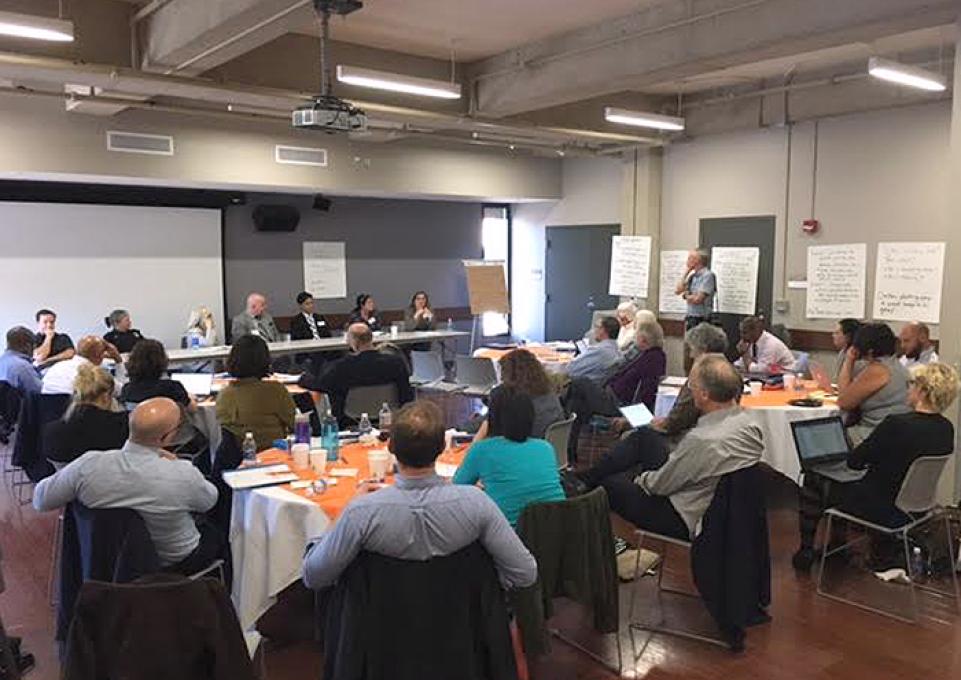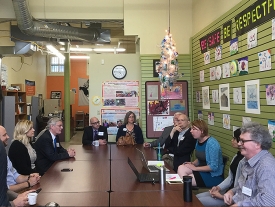
Buffalo State drew praise from community leaders for the many ways the college is engaged with the West Side neighborhood at a panel discussion on June 14. Representatives from organizations including the Belle Center, PUSH Buffalo, the Buffalo Police Department, and the Erie County Department of Health spoke at a meeting sponsored by the Democracy Collaborative and Buffalo State.
Ted Howard, co-founder and president of the Democracy Collaborative, said that the purpose of the two-day meeting was to focus on the anchor dashboard, a tool to measure the impact of anchor institutions on their neighborhoods. The Democracy Collaborative is an organization interested in community wealth-building.
Three years ago, the collaborative invited several higher education institutions, including Buffalo State, to join a cohort to explore, discuss, expand, and—most importantly—measure their impact as anchor institutions. Such institutions are primarily educational and medical, rooted in a neighborhood, and unlikely to move. They have a commitment to apply campus resources to better the communities in which they reside.
“We knew people at these institutions were seriously grappling with how best to express their mission as an anchor institution,” said Howard. “We wanted a small group to refine the anchor dashboard.”
The dashboard identifies a desired outcome for given issues. For example, the desired outcome might be “educated youth.” Community indicators of educated youth could include high school graduation rate; the corresponding indicator for the college might be the level of investment the college makes in the community in dollars and/or in staff involved in developing K–12 partnerships with the college.
 The two-day meeting began with a bus tour of Buffalo’s West Side neighborhood, conducted by Gary Welborn, professor of sociology. Welborn, who joined Buffalo State in 1993, is a long-time community activist. The group, including visitors from Cleveland State University, Drexel University in Philadelphia, Rutgers University-Newark, and the University of Missouri-St. Louis, stopped at Buffalo State’s Community Academic Center (CAC) on Grant Street (pictured at left). In the panel discussion the next day, Ba Zan Lin, a leader of Buffalo’s Burmese immigrant community, said that the CAC was important as a place where programming could take place. “Without the CAC, we might not have the opportunity to offer citizenship and language classes,” he said.
The two-day meeting began with a bus tour of Buffalo’s West Side neighborhood, conducted by Gary Welborn, professor of sociology. Welborn, who joined Buffalo State in 1993, is a long-time community activist. The group, including visitors from Cleveland State University, Drexel University in Philadelphia, Rutgers University-Newark, and the University of Missouri-St. Louis, stopped at Buffalo State’s Community Academic Center (CAC) on Grant Street (pictured at left). In the panel discussion the next day, Ba Zan Lin, a leader of Buffalo’s Burmese immigrant community, said that the CAC was important as a place where programming could take place. “Without the CAC, we might not have the opportunity to offer citizenship and language classes,” he said.
The next stop was dinner at the Burchfield Penney Art Center. “Community engagement is an important part of our culture here at Buffalo State,” President Conway-Turner told the guests. Ted Howard and Charles Rutheiser of the Annie E. Casey Foundation, which supports the Anchor Dashboard project, also spoke.
At the next day’s meeting, representatives from the cohort as well as attendees from other organizations shared their experiences. “Buffalo State has powerful links with community organizations,” Howard said, “so its team has contributed a lot to the discussion of how to strengthen and manage those relationships. Buffalo State is part of a much bigger state system, which raises a lot of interesting questions. And Bill Wieczorek has focused on community health, so he’s brought that idea in.” Wieczorek is director of the Institute for Community Health Promotion at Buffalo State.
John Siskar, senior adviser for educational pipeline initiatives, is involved in three major community engagement projects, including the anchor dashboard project. “Community engagement has always been part of Buffalo State’s DNA,” Siskar told the group at the meeting’s last session. “The next step is to institutionalize this work in alignment with our current strategic planning process.”
